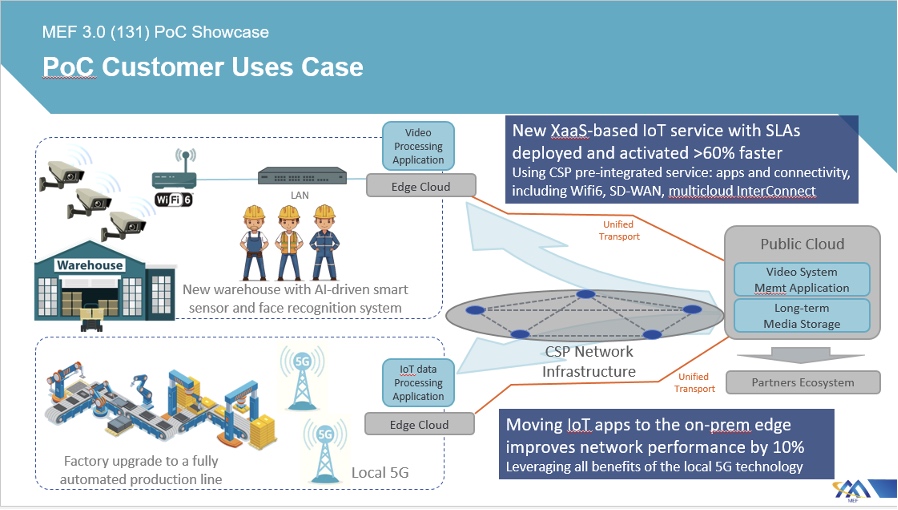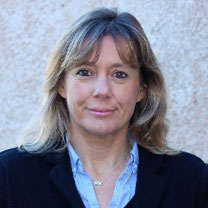
on Posted on Reading Time: 3 minutes
In Part 1: Building a Vertical Business Around Edge Cloud Services: Highlights from MEF 3.0 PoC Showcase 2021, the MEF PoC (131) team (NTT Communications, Netcracker, Microsoft, Juniper, ADVA) presented the challenges of implementing edge cloud services and how the PoC addresses those problems. Here, in Part 2, we take it a step further by explaining how the PoC was actually implemented, including intelligent resource placement across public and telco edge clouds, AI-driven assurance across multiple technology domains, as well as the obstacles that had to be overcome to make it all work.
Recap the Goals
The goal of our PoC is to make it easy for vertical industries to use the power of edge cloud to purchase mission-critical applications and services on demand from a Communications Service Provider (CSP). For example, enterprises can significantly improve time-to-market and production performance by purchasing managed cloud services—including high-value applications bundled with connectivity—from a CSP through a digital marketplace.
Scenarios
MEF 3.0 PoC (131) demonstrates two scenarios:
- To increase efficiency and productivity, an enterprise wants to open a new warehouse with Industry 4.0 technology, including AI-driven smart sensors and a facial recognition system. Choosing pre-integrated managed services from a CSP, including an IoT MEC service with Wi-Fi/LAN/WAN connectivity, allows the enterprise to deploy and activate the warehouse 60% faster than with a DIY solution.
- An automated factory needs to upgrade its 4G network infrastructure to achieve higher capacity and lower latency for its production line. By opting for an IoT MEC service, managed by the CSP, featuring end-to-end (E2E) connectivity and 5G network slicing, network performance is improved by 10%.

How We Made It Happen
Developing an automated and seamless cloud service to vertical industries required us to overcome many technology and business hurdles. We’ll cover a few of the key ones that are common to both scenarios:
1. Strong collaboration between CSPs and hyperscalers.
CSPs know they cannot address these vertical industries alone. To accommodate the diverse enterprise applications and use cases, CSPs and hyperscalers will need to collaborate in many different ways—both business and technology. In our PoC, we show how to:
- Instantiate an OTT IoT application in the CSP edge cloud platform.
- Instantiate a CSP secure SD-WAN VNF on an OTT edge cloud platform.
- Incorporate public cloud and its extension to the edge/premise into a CSP-managed service offering.
We also identified additional MEF LSO APIs to simplify this collaboration.
2. Automated intelligent placement of edge resources.
Knowing where to place critical service components is the next key step. Highly distributed edge cloud locations (on-premise and network edge), offered by multiple providers (CSP and hyperscaler), requires a combination of service orchestration and advanced analytics to select the best edge location for IoT applications to meet SLAs.
Intelligent placement is based on many factors, including edge cloud capacity, inter-site bandwidth, IoT service type and meaningful capacity parameters (video stream bandwidth, camera quantity), and service performance statistics. The whole process, including feature placement, activation, and service deployment requires advanced automation leveraging E2E orchestration and MEF’s LSO framework across the different technology domains.
3. Flexible on-demand connectivity from LAN to the public cloud.
An IoT environment, in which applications can be dynamically placed on-premise clouds, network edges, or public clouds, needs an on-demand, flexible network that can rapidly adapt to match the application requirements. In our PoC, we took a new E2E approach by interconnecting Wi-Fi/LAN, SD-WAN, and multi-cloud interconnect domains with the help of AI. Through orchestration, we achieved zero-touch provisioning of all the connectivity options, using the AI engine for unprecedented insights and automation.
4. AI-driven assurance with machine learning.
CSP cloud services management will demand strict E2E SLAs. Our goal is to minimize any network or service failure by fixing issues before they impact end-customer services, despite the challenges of implementation across such a complex multi-domain technology environment. The PoC demonstrates how we achieved this goal with AI-driven E2E assurance. The assurance process incorporates machine learning to not only anticipate and react to network failures, but also to continuously monitor the quality from site to core.
Summary
MEF 3.0 PoC (131) illustrates that CSPs can only competitively offer advanced edge cloud services by using ecosystem-based automation platforms that stitch together the diverse technology domains. AI-driven automation is key for every stage, including ordering, provisioning, assurance and optimization.
Learn More
Also read our other blog post: Part 1: Building a Vertical Business Around Edge Cloud Services: Highlights from MEF 3.0 PoC Showcase 2021
Read more about: MEF 3.0 PoC (131) Orchestrating Multi-Edge Cloud Services
This PoC was presented at the MEF PoC Showcase in Q1 2021. Watch the Presentations on YouTube
About MEF’s PoC Program & Showcase
The MEF 3.0 Proof of Concept program effectively fosters innovation, seeds new MEF standards and projects, and accelerates our existing work within the ICT industry by providing our members—including service providers, technology suppliers, and other stakeholders within the ICT industry—the opportunity to collaborate on MEF 3.0-based use cases throughout the year.
Initiated by MEF members and facilitated by MEF staff, each MEF 3.0 PoC receives a unique, identifying number that remains unchanged as its title and messaging evolves over the life of the project.
PoC work is highlighted in public showcases and award presentations that explore individual Proofs of Concept. Learn more about these enabling technologies and the MEF 3.0 PoC Program.
About MEF’s PoC Program & Showcase
The MEF 3.0 Proof of Concept program effectively fosters innovation, seeds new MEF standards and projects, and accelerates our existing work within the ICT industry by providing our members—including service providers, technology suppliers, and other stakeholders within the ICT industry—the opportunity to collaborate on MEF 3.0-based use cases throughout the year.
Initiated by MEF members and facilitated by MEF staff, each MEF 3.0 PoC receives a unique, identifying number that remains unchanged as its title and messaging evolves over the life of the project.
PoC work is highlighted in public showcases and award presentations that explore individual Proofs of Concept. Learn more about these enabling technologies and the MEF 3.0 PoC Program.

